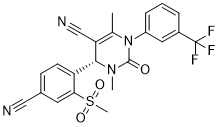BAY 85-8501
This product is for research use only, not for human use. We do not sell to patients.

For small sizes, please check our retail website as below: www.invivochem.com
| Size | Price | Stock |
|---|---|---|
| 100mg | $2950 | To Be Conmfirmed |
| 200mg | $4425 | To Be Conmfirmed |
| 500mg | $7465 | To Be Conmfirmed |
Cat #: V4182 CAS #: 1161921-82-9 Purity ≥ 98%
Description: BAY 85-8501 is a novel, highly potent and selective inhibitor of Human Neutrophil Elastase (HNE) with an IC50 of 65 pM.
Top Publications Citing Invivochem Products
Publications Citing InvivoChem Products
Product Promise

- Physicochemical and Storage Information
- Protocol
- Related Biological Data
- Stock Solution Preparation
- Quality Control Documentation
| Molecular Weight (MW) | 474.46 |
|---|---|
| Molecular Formula | C22H17F3N4O3S |
| CAS No. | 1161921-82-9 |
| Storage | -20℃ for 3 years in powder formr |
| -80℃ for 2 years in solvent | |
| SMILES Code | N#CC1=C(C)N(C2=CC=CC(C(F)(F)F)=C2)C(N(C)[C@@H]1C3=CC=C(C#N)C=C3S(=O)(C)=O)=O |
| Synonyms | BAY 858501; BAY858501; BAY-858501; BAY 85-8501; BAY85-8501; BAY-85-8501; |
| Protocol | In Vivo | In this model the exogenous HNE noxa is the primary cause of injury and lung hemorrhage. Based on picomolar potency against HNE as well as single digit potency versus MNE, BAY-85-8501 (29) completely prevents the development of lung injury and subsequent inflammation when administered 1 h prior to the HNE noxa. In the 0.01 mg/kg dose group, hemoglobin concentration is already significantly decreased. At a dose of 0.1 mg/kg, a significant effect on neutrophil count is observed. In this setup, efficacy is predominantly driven by potency against HNE (Ki=0.08 nM). As the highly HNE-selective inhibitor BAY 85-8501 has no effect on PPE, BAY-85-8501 could not prevent the primary lung injury in this setup. Nevertheless, BAY-85-8501 could inhibit MNE, the endogenous driver of inflammation and secondary injury, although with decreased potency. Consequently, the effects of BAY-85-8501 on inflammation and secondary injury are weaker at this point, and only observed at 30-fold higher doses. Efficacy is predominantly driven by potency against MNE (Ki=6 nM) in this second setup. |
|---|
These protocols are for reference only. InvivoChem does not
independently validate these methods.
| Solvent volume to be added | Mass (the weight of a compound) | |||
|---|---|---|---|---|
| Mother liquor concentration | 1mg | 5mg | 10mg | 20mg |
| 1mM | 2.1077 mL | 10.5383 mL | 21.0766 mL | 42.1532 mL |
| 5mM | 0.4215 mL | 2.1077 mL | 4.2153 mL | 8.4306 mL |
| 10mM | 0.2108 mL | 1.0538 mL | 2.1077 mL | 4.2153 mL |
| 20mM | 0.1054 mL | 0.5269 mL | 1.0538 mL | 2.1077 mL |
The molarity calculator equation
Mass(g) = Concentration(mol/L) × Volume(L) × Molecular Weight(g/mol)
Mass
=
Concentration
×
Volume
×
Molecular Weight*
The dilution calculator equation
Concentration(start)
×
Volume(start)
=
Concentration(final)
×
Volume(final)
This equation is commonly abbreviated as: C1 V1 = C2 V2
Concentration(start)
C1
×
Volume(start)
V1
=
Concentration(final)
C2
×
Volume(final)
V2
Step One: Enter information below
Dosage mg/kg
Average weight of animals g
Dosing volume per animal µL
Number of animals
Step Two: Enter the in vivo formulation
%DMSO
+
%
+
%Tween 80
+
%ddH2O
Calculation Results:
Working concentration:
mg/ml;
Method for preparing DMSO master liquid:
mg
drug pre-dissolved in
µL
DMSO(Master liquid concentration
mg/mL)
,Please contact us first if the concentration exceeds the DMSO solubility of the batch of drug.
Method for preparing in vivo formulation:
Take
µL
DMSO master liquid, next add
µL
PEG300, mix and clarify, next add
µL
Tween 80,mix and clarify, next add
µL
ddH2O,mix and clarify.
Note:
- (1) Please be sure that the solution is clear before the addition of next solvent. Dissolution methods like vortex, ultrasound or warming and heat may be used to aid dissolving.
- (2) Be sure to add the solvent(s) in order.




































